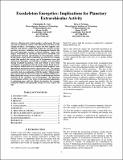Exoskeleton energetics: Implications for planetary extravehicular activity
Author(s)
Carr, Christopher E.; Newman, Dava
DownloadExoskeleton Energetics_2017.pdf (1.632Mb)
OPEN_ACCESS_POLICY
Open Access Policy
Creative Commons Attribution-Noncommercial-Share Alike
Terms of use
Metadata
Show full item recordAbstract
Humans first visited another world nearly 50 years ago and are poised to return to the Moon and visit Mars in the coming decade(s). Developing a space suit that supports safe, efficient, and effective exploration despite the extremes of temperature, pressure, radiation, and environmental hazards like dust and topography remains a critical challenge. Space suits impose restrictions on movement that increase metabolic rate and limit the intensity and duration of extravehicular activity. In this study, a lower body exoskeleton was used to test a simple model that predicts the energy cost of locomotion across gait and gravity. Energetic cost and other variables were measured during treadmill locomotion, with and without a lower body exoskeleton, in simulated reduced gravity and in Earth gravity. Six subjects walked and ran at constant Froude numbers, non-dimensional parameters used to characterize gait. The springlike energy recovery of the exoskeleton legs was estimated using energetics data in combination with the model. Model predictions agreed with the observed results (no statistical difference). High spring-like energy recovery of the exoskeleton legs lowered measures of the energetic cost of locomotion. For planetary extravehicular activity, our work reveals potential approaches to optimizing space suits for efficient locomotion, for example, tuning the stiffness and spring-like energy recovery of space suit legs.
Date issued
2017-06Department
Massachusetts Institute of Technology. Department of Earth, Atmospheric, and Planetary SciencesJournal
2017 IEEE Aerospace Conference
Publisher
Institute of Electrical and Electronics Engineers (IEEE)
Citation
Carr, Christopher E., and Dava J. Newman. "Exoskeleton Energetics: Implications for Planetary Extravehicular Activity." 2017 Aerospace Conference, 4-11 March, 2017, Big Sky, Montana, IEEE, 2017, pp. 1–14.
Version: Author's final manuscript
ISBN
978-1-5090-1613-6